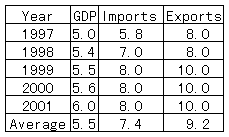Egypt has now entered a difficult stage of economic reform. The privatization process is likely to proceed slowly and the government may face opposition to some of the proposed deregulation and legislative reforms. This may stall the move to higher growth, which is needed to maintain a fast growing population. Economic growth may also suffer if tourism declines following recent problems. Despite these potential difficulties, the Economist Intelligence Unit (EIU), whose analyses generally reflect those of other authoritative international agencies, forecasts GDP growth in Egypt of 5-6% over the next five years. This reflects an expectation of steady economic growth, which is aided by a cheap labour force and strong foreign investments helping exports. This predicted GDP growth rate, however, continues to stay well below that achieved by the new Asian “tiger” economies. Table 1.2.2 shows the EIU's predicted growth in GDP and trade imports and exports annually up to 2001. And the real growth in 1997-1998 was 5%.
Table 1.2.2 Forecast of Growth in Egyptian GDP and trade (%)

Source: ElU country Forecast Update, 4th quarter 1997
Table 1.2.3 broadens the future GDP growth rate predictions to reflect the average value of predictions from a number of recognized economic sources. The predicted rates of inflation and exchange rate predictions to 2001 are also included.
Table 1.2.3 Real and Predicted Growth and Inflation

: Predicted values
1.2.2 Outline of Suez Canal
The idea of creating a Canal linking the Mediterranean Sea to the Red Sea is a very old one that dates back to 4000 years when the Ancient Egyptians thought of linking the two Seas using the River Nile and its branches. It was this very old idea that led to the digging of the present Suez Canal which is historically the first man-made Canal ever dug in services of world trade and is, so far, the biggest navigational Canal between East and West.
The Suez Canal is a sea level Canal and the height of the tide differs slightly as it is 50cm high in the north and 2m high in the south. The banks of the Canal are protected against the great wash generated by the transit of ships by revetment of hard stones and steel piles corresponding to the nature of the soil in every area. On both sides of the Canal there are mooring bollards every 125m for the mooring of vessels in case of emergency, and kilometric sign posts helping locate the position of ships in the waterway. The navigable channel is bordered by lights and reflecting buoys as a navigational aid to night traffic.
前ページ 目次へ 次ページ